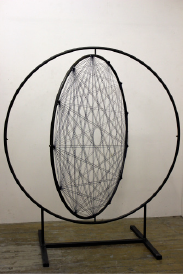Sculpture: Stranger Than Paradise 2013
[with physicist Ian Shipsey Oxford University/ UK]
In the six sculptures which make up, magnetised objects hang in steel frames with dimensions taken from Giacometti's early Surrealist works. They operate in abstract terms, but also reference scientific modelling, and in doing so they alternate between micro and macro levels. Just what are those cratered balls with blind alleys, tunnels and holes? Atomic particles? Planets? Or people in relationships? Gill points to the potential narrative of those relations through the sub-titles of these pieces, all of which incorporate a fairy tale which can also be read as linking to one of the six particles which are quarks in the Standard Model: Sleeping Beauty (Beauty/Bottom); Rumpelstiltskin (Strange); Tom Thumb (Down); Rapunzel (Truth/Top); Frog Prince (Charm) and Magic Bean (Up).
The science of Stranger Than Paradise is too simple to deceive. Everyone understands magnetic force. Yet a residual air of mystery does remain whenever bodies act without visible cause. And if the objects do stand in for people, they put me in mind of how behaviour can appear to come from nowhere, even the extremes which are seen in those early Giacometti sculptures. Our speculation as to causes will be rooted in psychology rather than science. That might set us wondering, though, whether the former might eventually be reduced to the latter through an ultimate understanding of the chemistry and physics of the brain, just as the sculpture's interactions can be explained by magnetic and gravitational laws. What are the shapes, by the way? Gill explains that they all began from either the sphere or a Russian doll, and that, too, provides an appropriate combination of contrasts: they start from either perfect rationalism, for which read science or maths; or from a sequential concatenation of myth, from art or religion.
Detector (Kissing Gate) 2013
Uses the invisible force of magnetism, but to rather different effect – to influence the opening, closing and turning of a sculptural circle which becomes a portal. Here again the art and non-art references come together. This is a gate, a potential point of entry to alternative experiences, including, perhaps, the magnetic attractions of romance. It also looks like a bicycle wheel removed from its context, which summons Duchamp’s first readymade. The sculptural placement of string across a hole brings Barbara Hepworth to mind. But its pattern takes us back to Gill’s interest in topology: it’s a ‘Mystic Rose’’ produced by linking equidistant points around a circle to each other.
